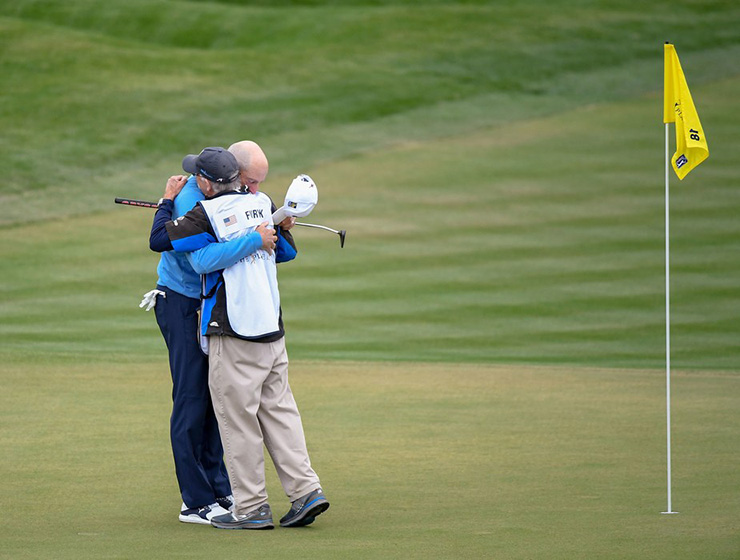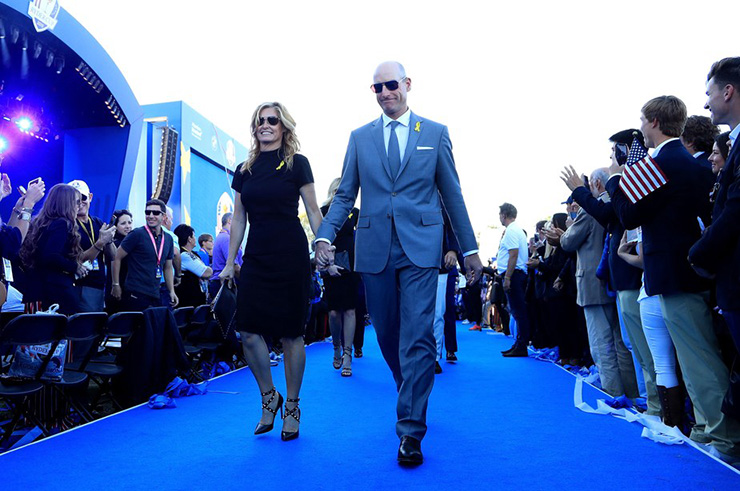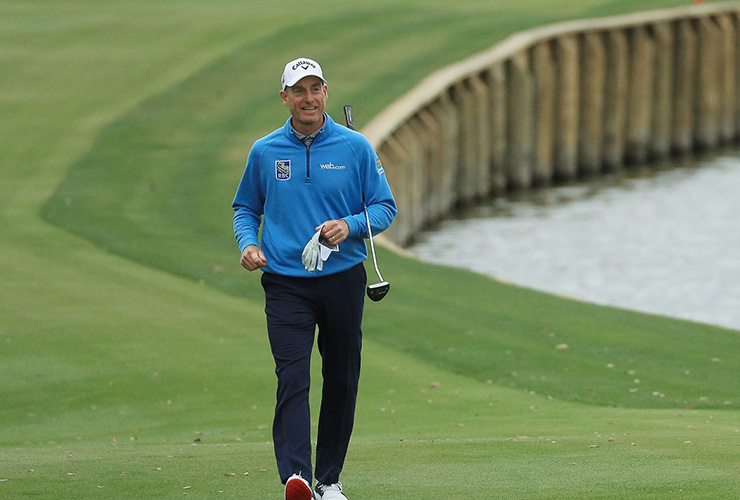By John Feinstein
If you want to understand who Jim Furyk is and why he is a lock to be in the World Golf Hall of Fame someday soon, consider how he met his wife Tabitha.
It was May 1995. Furyk was in his second year on the PGA Tour—known mostly for being the guy with the funny-looking swing—and was playing in the Memorial for the first time. Tabitha had gone out to the tournament on Thursday with some friends, and they were hanging out near the scoring area watching the various golfers come through after they’d finished their rounds.
Tabitha noticed one player taking more time to sign autographs and talk to the various kids who waited for the players as they came out after signing their cards. In some cases, he crouched down to get to eye level with the little ones. She was impressed.
“A friend introduced us, and I told him that I thought it was really nice of him to take that kind of time with the kids,” Tabitha said, years later. “I told him I’d worked as a teacher and I liked seeing someone go out of their way to be so good with the kids.”
Jim was both surprised and dazzled by the strikingly pretty blonde who he had noticed almost as soon as he finished signing his scorecard.
“So I did something I had never done before in my life,” he said, laughing at the re-telling. “I asked her if she’d like to have dinner with me. I don’t know where I found the guts to do it, but I’m glad I did. Ultimate example of out-kicking your coverage.”
Furyk’s been out-kicking his coverage his entire golf career. Very few people took him all that seriously when he first made it through the old PGA Tour Q School in 1993 because his swing looked like something out of a comedy routine. His teacher then—as now—was his father Mike, and both Furyks have always said the same thing about Jim’s swing: Why change what’s working?
This past weekend, less than two months shy of Furyk’s 49th birthday, the 43-piece swing was still working. As a bunched field came barreling to the finish line at the Players Championship, there was Furyk, giving away many years and even more yardage to all the other leaders, hanging right with Rory McIlroy (age 29); Jon Rahm (24); Jhonny Vegas (34); Tommy Fleetwood (28); and Eddie Pepperell (28).
He ended up one shot shy of McIlroy, after shooting 67 but finishing with a flourish—a birdie on the 18th hole at TPC Sawgrass after hitting his approach shot to within three feet. Only McIlroy’s two late birdies on 15 and 16 denied Furyk a shot at the 18th PGA Tour victory of his career.

Furyk is congratulated by his caddie, Mike (Fluff) Cowan, after making birdie on TPC Sawgrass’ 18th hole to close out the tournament. (Chris Condon/PGA Tour)
What’s perhaps most remarkable is this: Furyk hasn’t finished in the top 125 in the FedEx Cup standings since 2016. There are very good reasons for this: In 2016, he missed the first four months of the year with a wrist injury, then played so well—including a T-2 finish at the U.S. Open—that Davis Love III seriously considered making him a captain’s pick for the American Ryder Cup team at Hazeltine National.
In a classic Furyk moment, HE was the one who removed himself from consideration. Playing a practice round with Love at Hazeltine the week before the matches began, he turned to Love after both men had failed to reach one of the course’s long par 4s in two and said, “Davis, my best chance to help this team is as one of your assistant captains. This golf course is too long for me.”
That wasn’t an easy thing for Furyk to do. He had played on nine straight Ryder Cup teams, dating to 1997. But he has always been a realist—except perhaps that fateful day in Columbus when he met Tabitha.
Injuries cropped up again in 2017—this time a nagging shoulder problem that forced him to shut down after the PGA Championship and not return until the Genesis Open in February 2018. It has been a long climb back since then, but the Players was his third top-10 finish of this season, coming just two weeks after he a T-9 at the Honda Classic.
At this point in his life, Furyk should be counting down the 14 months left until he’s eligible to play with the 50-and-older set on the PGA Tour Champions, where his accuracy and putting ability will more than offset his relative lack of distance off the tee.
But that’s not how Furyk’s built. He almost enjoys being doubted—which he has been ever since he was playing junior golf. “Never really bothered me,” he has often said of people making fun of his swing. “As long as I played well, what did I care what people said about my swing?”
Furyk went more than 4½ years without winning after winning three times in 2010 and remained undaunted until he broke the skein at Hilton Head in 2015. He’s done just about everything you can hope to do in golf: He’s won a major (the 2003 U.S. Open); he’s won the FedEx Cup (2010); he’s played on nine Ryder Cup teams and captained one; he’s won 17 times on tour; he was the first player to ever shoot 58 in a tour event (2016 Travelers) and—as Tabitha witnessed at that long-ago Memorial—has always been one of golf’s good guys.
Last September in Paris, Furyk willingly took the blame for his Ryder Cup team’s loss to Europe. However, those who were there and, for that matter, those who weren’t there, will tell you that this was one loss that couldn’t be blamed on the captain. Unless he was somehow responsible for Phil Mickelson and Tiger Woods combining to go 0-6 for the week.

Furyk and wife, Tabitha, depart after the opening ceremony for the 2018 Ryder Cup at Le Golf National outside Paris. (Andrew Redington)
The combination of being Ryder Cup captain, and the time commitment that entails, and his injuries, led to two miserable years for someone who had been one of golf’s most consistent players since he first made it through Q School in 1993.
That was where I first saw Furyk play. A couple of other players told me I had to watch him swing a golf club. Of course, being the brilliant golf analyst I am, I thought, “no chance this guy lasts on tour.”
I got to know him during his rookie year while researching A Good Walk Spoiled and quickly became a fan if only because I enjoyed his self-deprecating sense of humour. Furyk was—and is—one of those guys who takes his job seriously but not himself.
He has always been one of the more thoughtful players on tour. Careful, but thoughtful. Several years ago, I was writing a magazine piece on Tiger Woods and, since Furyk got along with him and was one of the few guys who’d had success partnering with him in Ryder Cup, I went to talk to him about Woods. His answers were smart and funny. Each time I asked a question, there was a long pause before he answered. That wasn’t like him. So, I asked why.
“Because you’re asking about Tiger,” he said.
Why would that cause him to take more time answering?
“Because,” he said, “when you talk about Tiger, more people are listening.”
I ran into Furyk in the locker room a couple of weeks ago at the Honda. He had just shot a one-under-par 71 in the first round of the tournament. “How you feeling out there?” I asked.
He shrugged and smiled. “Pretty good actually. I think it’s coming.” He paused and added with a chuckle, “I’m sure that’s the first time you’ve heard a player say that.”
Two weeks later, there was Furyk duking it out down the stretch with a posse of the game’s younger stars. And, as always, not backing down even a little bit. It’s been almost 24 years since Furyk first met his future wife and “out-kicked his coverage.”
He’s still doing it.








